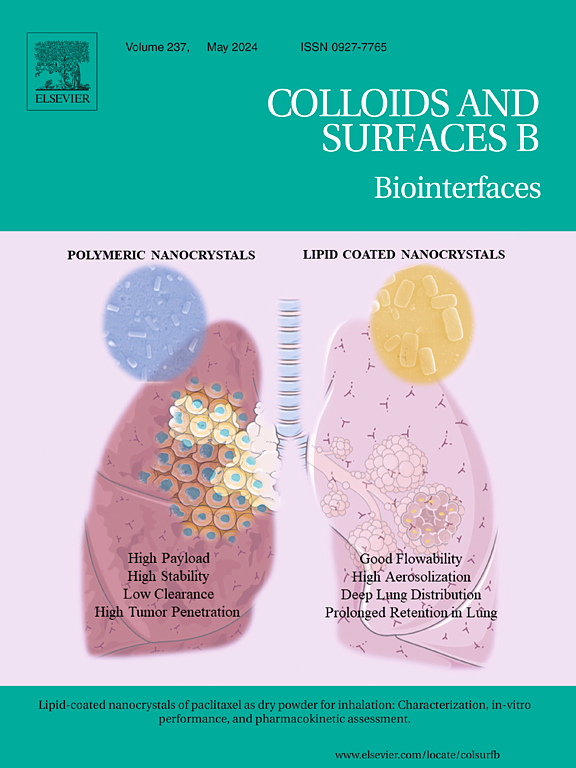Nanozyme-synbiotics to improve iron-deficiency anemia
IF 5.4
2区 医学
Q1 BIOPHYSICS
引用次数: 0
Abstract
Iron deficiency anemia (IDA) affects approximately one-third of the global population, and conventional treatments often face challenges such as poor absorption and adverse effects. This study investigated the therapeutic potential of Bacteroides ovatus (BO) and its synergistic combination with MIL-101(CuFe) nanozyme for IDA. The results demonstrated that BO significantly enhanced intestinal iron absorption by upregulating the expression of the duodenal iron transporter ZIP14 and ferroportin (Fpn). Concurrently, BO improved iron transport and storage by upregulating the protein expression of hepatic transferrin receptor 1 (TFR1) and ferritin subunits FTH/L. Furthermore, BO significantly downregulated the protein expression of hepatic hepcidin, thereby maintaining Fpn function. Subsequently, synthesized MIL-101(CuFe) nanozyme, exhibiting prebiotic properties, was found to significantly promote BO growth (by more than 3-fold). The combination of BO and MIL-101(CuFe) formed the CuFeBO "nanozyme-synbiotics", which substantially alleviated IDA by synergistically improving iron absorption (Fpn), transport (TFR1), and storage (FTH/L). In conclusion, this study elucidates the mechanism by which BO and the CuFeBO nanozyme-symbiont effectively alleviate IDA through multi-targeted, precise modulation of iron absorption, transport, and storage pathways. This synergistic strategy successfully overcomes the limitations of low absorption rates and significant side effects associated with conventional iron therapies, providing a crucial theoretical foundation and broad application prospects for developing novel, efficient, and safer treatments for IDA.
纳米酶合成制剂改善缺铁性贫血
缺铁性贫血(IDA)影响着全球约三分之一的人口,常规治疗方法往往面临吸收不良和不良反应等挑战。本研究探讨了卵形拟杆菌(Bacteroides ovatus, BO)及其与MIL-101(CuFe)纳米酶的协同作用对IDA的治疗潜力。结果表明,BO通过上调十二指肠铁转运蛋白ZIP14和铁转运蛋白Fpn的表达,显著促进肠道铁吸收。同时,BO通过上调肝转铁蛋白受体1 (TFR1)和铁蛋白亚基FTH/L的蛋白表达来改善铁的运输和储存。此外,BO显著下调肝脏hepcidin的蛋白表达,从而维持Fpn的功能。随后,合成的MIL-101(CuFe)纳米酶具有益生元特性,可显著促进BO生长(提高3倍以上)。BO与MIL-101(CuFe)结合形成CuFeBO“纳米酶-合成酶”,通过协同提高铁的吸收(Fpn)、运输(TFR1)和储存(FTH/L),显著缓解IDA。综上所述,本研究阐明了BO和CuFeBO纳米酶共生体通过多靶点、精确调节铁的吸收、运输和储存途径有效缓解IDA的机制。这种协同策略成功克服了传统铁疗法吸收率低和副作用大的局限性,为开发新型、高效、安全的IDA治疗方法提供了重要的理论基础和广阔的应用前景。
本文章由计算机程序翻译,如有差异,请以英文原文为准。
求助全文
约1分钟内获得全文
求助全文
来源期刊

Colloids and Surfaces B: Biointerfaces
生物-材料科学:生物材料
CiteScore
11.10
自引率
3.40%
发文量
730
审稿时长
42 days
期刊介绍:
Colloids and Surfaces B: Biointerfaces is an international journal devoted to fundamental and applied research on colloid and interfacial phenomena in relation to systems of biological origin, having particular relevance to the medical, pharmaceutical, biotechnological, food and cosmetic fields.
Submissions that: (1) deal solely with biological phenomena and do not describe the physico-chemical or colloid-chemical background and/or mechanism of the phenomena, and (2) deal solely with colloid/interfacial phenomena and do not have appropriate biological content or relevance, are outside the scope of the journal and will not be considered for publication.
The journal publishes regular research papers, reviews, short communications and invited perspective articles, called BioInterface Perspectives. The BioInterface Perspective provide researchers the opportunity to review their own work, as well as provide insight into the work of others that inspired and influenced the author. Regular articles should have a maximum total length of 6,000 words. In addition, a (combined) maximum of 8 normal-sized figures and/or tables is allowed (so for instance 3 tables and 5 figures). For multiple-panel figures each set of two panels equates to one figure. Short communications should not exceed half of the above. It is required to give on the article cover page a short statistical summary of the article listing the total number of words and tables/figures.
 求助内容:
求助内容: 应助结果提醒方式:
应助结果提醒方式:


